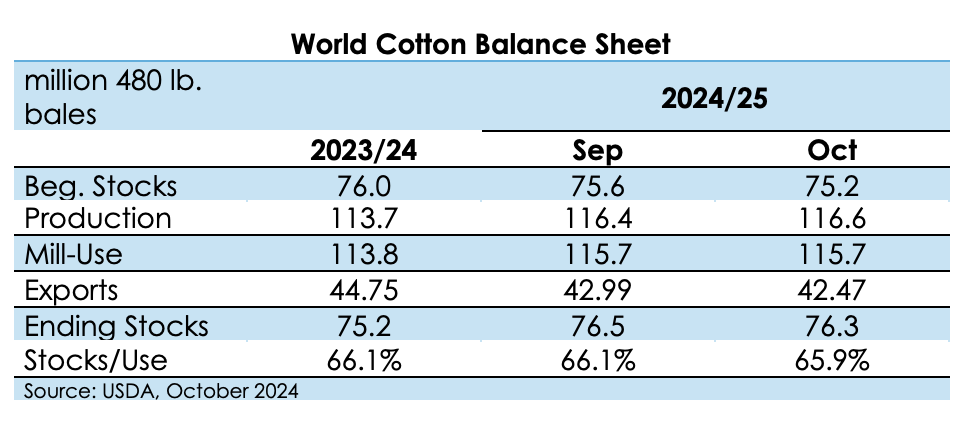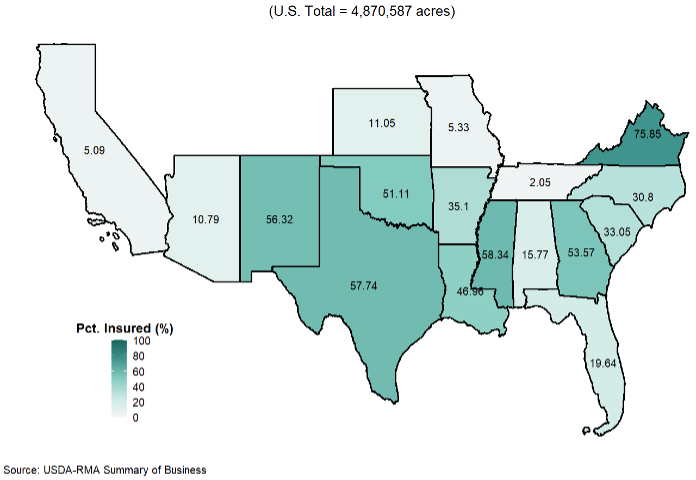On Monday, March 31st, USDA released the Prospective Plantings report. These acreage estimates are based primarily on surveys conducted by the National Agricultural Statistics Service (NASS) from February 18 to March 18. Principal crop acres planted were projected nationally at nearly 310 million acres, down roughly 1.3 million acres compared to last year. Corn acres are estimated at 95.3 million, up 4.7 million from last year and the third highest in modern history. Soybean planted acres are estimated at 83.5 million, down almost 3.6 million from last year. Cotton acres are projected to be down 12% from last year, at 9.867 million acres, the lowest since 2015. Peanut acreage is projected at 1.95 million acres, up 8% from last year, and rice acres are projected at 2.895 million, down 1% from last year. All wheat acreage is projected at 45.35 million, down 2% from last year. The forecasts in the Prospective Plantings report confirm recent projections released at the February USDA Outlook Forum which had 2025 corn acres increasing by 3.4 million, a 3.1-million-acre reduction in soybeans, and 1.18 million fewer acres of cotton.
In fact, the USDA indicated in the Prospective Plantings report an even larger increase in corn acres compared to last year. Throughout the first quarter of 2025, new crop corn-soybean futures price ratios heavily favored corn over soybeans ranging from 2.20 to 2.31, driven by tightening U.S. and World corn stocks. In fact, the price ratio averaged 2.24 during the window of the 2025 March Prospective Plantings survey compared to 2.49 in the same time frame last year. Cotton was expected to cede acres this year due to struggling demand, intense export competition with Brazil, and lower prices compared to other commodities. All states except Arizona and Kansas are projected to reduce cotton acreage from last year. Rice acres are also expected to decline on lower prices, static input costs and fierce export competition from Asian origins. Seed availability for long-grain rice is an additional factor reducing acres. Futures price reaction from the March 31 report was subdued, with the findings in the Prospective Plantings report mostly in agreement with pre-report industry estimates. New crop (i.e., Fall 2025) corn settled one-half cent lower, soybeans 9 ¾ cents lower, cotton 17 points ($0.0017) lower, and rice 1 ½ cents per cwt. lower.
We now provide a 2025 update to a 2023 Southern Ag Today article addressing the reliability of the Prospective Plantings report (Biram and Maples, 2023). The NASS planted acreage projections across the U.S. continue to hold well with low predictive error and hold especially well for corn and soybeans over the 2016-2024 time span (Figure 1). There still remains a relatively small predictive error for rice and cotton over the same time span. The larger variance can be due to (1) the smaller sample size of farms and (2) the alternative crops available to plant in place of corn and soybeans. Most of the U.S. corn and soybean acreage is grown in the upper Midwest but tends to take up acreage across the entire U.S. which allows for a larger sample of farmers and less variance. In the south, farmers rotate corn and soybean crops with cotton, peanuts, and even some vegetables. This makes it more difficult to project acres that may shift based on rotational needs, commodity prices, input costs, and weather.
We re-investigate the difficulty in projecting acreage by choosing the subsample of southern states to see if 1) there is more variance across the changes in corn and soybean acreages given a smaller sample and 2) the pattern of acreage changes across cotton and rice still holds in the subsample. We find this to continue to hold (Figure 2). We see more differences each year between prospective and actual planted acreages in corn and soybeans across southern states, and the general pattern of differences each year for cotton and rice still holds between the full U.S. sample and the southern subsample. This implies that we should generally not expect any significant changes in harvest price expectations driven by differences in planted acreages but rather look to future market-moving events. The continuation of drought conditions in West Texas has implications for the cotton market, while prolonged drought in the western Corn Belt has implications for corn and soybean production, as evidenced in 2023 (Gardner and Biram, 2023). Looking globally, we turn to weather-related impacts to the second Brazilian corn crop, as well as a future path on trade talks with our top trading partners (i.e., Mexico, Canada, and China).
Figure 1. Comparison of Prospective vs. Actual Planted Acreage across the U.S. (2016-2025)

Figure 2. Comparison of Prospective vs. Actual Planted Acreage across Southern[1] States (2016-2025)

[1] States included are Alabama, Arkansas, Florida, Georgia, Kentucky, Louisiana, Mississippi, North Carolina, Oklahoma, South Carolina, Tennessee, Texas, Virginia.
References:
Biram, Hunter, and William E. Maples. “Key Takeaways and Reliability of the 2023 Prospective Plantings Report.” Southern Ag Today 3(14.1). April 1, 2023. Permalink
Gardner, Grant, and Hunter D. Biram. “USDA Acreage Report Results: Price and Crop Insurance Impacts.” Southern Ag Today. July 3, 2023. Permalink
NASS/USDA. Prospective Plantings. National Agricultural Statistics Service, U.S. Department of Agriculture, March 2025. Retrieved from: https://release.nass.usda.gov/reports/pspl0325.pdf
Stiles, H. Scott, and Hunter Biram. “Key Takeaways of the 2025 Prospective Plantings Report and Revisiting Reliability.” Southern Ag Today 5(14.3). April 2, 2025. Permalink






